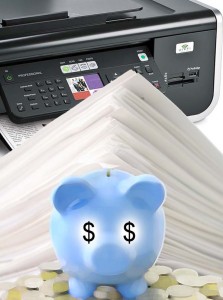So you have to do some heavy-duty, high volume printing? In that case, you may be planning to head out to a print shop, assuming that would be more cost-efficient that using your home printer. Well, yes… and no.
While printing at home does not usually yield a competitive cost per page, there are some strategies you can adopt to achieve higher cost-efficiency. In contrast, if you plan to print your books in bulk, or if you would like to get them bound (discover this here), then printing shops near you could be a preferred choice. You can even bargain with them to give you at a lesser cost. This article will point out several ideas that could help make it worthwhile to start printing reams of paper right from the comfort of your home office.
Toner vs Inkj et
et
When you purchased your printer, you likely had to decide between an inkjet and a laser printer. If you’re like most users, you probably went for the inkjet model, since it looked a bit cheaper while offering a pretty impressive set of features. In that case… sorry to burst your bubble, but you have made the wrong choice – assuming you need to print in volume.
Here’s the deal: a single inkjet cartridge will last a few hundred sheets of paper (best case scenario), while a toner cartridge can go well into the thousands. That’s why inkjet printers are so cheap these days – because manufacturers realize their profits mostly from selling cartridge replacements; that’s also why you never see a “cost-per-page” estimative when comparing printers, otherwise inkjet printers would quickly turn obsolete.
The bottom line being, if you’re really serious about low-cost high-volume printing at home, you should consider upgrading to a toner-based laser printer. The initial investment may set you back a couple hundred dollars, but you’ll get much higher cost efficiency in your subsequent printings. No worries, though… if you’re stuck with an inkjet printer and you can’t afford to upgrade right now, there are other inexpensive ideas for you to consider.
Recycled Cartridges
It doesn’t matter whether you’re stuck with an inkjet printer or if you own a laser printer; when the time comes to get a new cartridge, you should always go recycled. There are companies specializing in selling recycled cartridges compatible with pretty much any printer available on the market, and the cost is drastically cheaper when compared to getting a new cartridge from the original manufacturer. Recycled ink cartridges and toners work just as well, and are sold in several variants – including cartridge recycling kits that you can use to refill your brand cartridge over and over, by yourself, using a special needle included in the package. This kind of solution is by far the most inexpensive, and it will drastically bring down your costs with replacing cartridges, even if you’re using an inkjet printer.
Draft Quality Printing
This is the most universal and simple method to sake ink while printing at home… and so many people fail to observe it. When you print out a document, you can choose between at least three quality levels – usually along the lines of “draft”, “normal”, and “premium”. When printing something for your own consumption (or a friend’s), you want to always set the quality to “draft”. No worries, it will still look perfectly legible – except the blacks won’t be quite as deep and intense. There is really no point in choosing the highest quality settings on your printer unless you need a printout to look the very best. Otherwise, the lower quality/lower cost trade-off is absolutely worth it though, and just by following this idea you’ll instantly save half the ink in every print job you do.
Duplex Printing
Most printers these days support “duplex printing”, which is a fancy term for automatically printing on both sides of the paper. If you choose this option, you’ll automatically cut your paper costs in half, regardless of the print quality level you choose. Combine this idea with draft quality printing, and your savings will be substantial even if you’re stuck with an inkjet printer.
Page Imposition
If you want to take the duplex printing concept a step further (and assuming you’re an intermediate user), look for a way of doing page imposition. This can be done quite easily using pagination software such as InDesign or even stand-alone scripts; essentially, it’s the process of reorganizing the pages in a document so that you can print two document pages per side of a sheet of paper. Not in sequential order, but in a way that you can fold the print-out sheets over themselves and end up with a booklet where all the pages are neatly organized in reading order. This is actually the same process used in book-binding (where a master document is split in several booklets/signatures, which are then sewn together and glued to a cover). It can be much practical and especially useful when you need to print out a PDF document with many pages in a big font.
